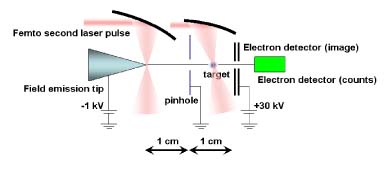Studying fast dynamics of molecular motion is a rapidly growing field of study ever since Ahmed Zewail won the 1999 Nobel prize for his work. A femto-second laser is used to generate an electron pulse which is scattered from a molecule to obtain structural information. The femto-second pulse is also fired at the molecule and after an adjustable delay the molecular structure is probed with the electron pulse. In essence a movie is made of the atomic motion in the molecule. The state-of-the-art time resolution of the "movie" is limited by the width of the electron pulse. The electron pulse is made by hitting a surface with the same femto-second laser. However, when the electrons are extracted from the surface the best electron pulse resolution turns out to be about one pico-second. Because molecular dynamics has timescales that extends deep into the femto-second range, it would be extremely exciting to overcome this limitation. We hope to do this by "laser"-extracting electrons from a field emission tip.
